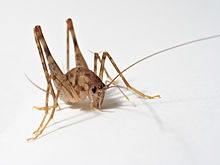Cave cricket
| Rhaphidophoridae | |
|---|---|
 |
|
| Scientific classification | |
| Kingdom: | Animalia |
| Phylum: | Arthropoda |
| Class: | Insecta |
| Order: | Orthoptera |
| Suborder: | Ensifera |
| Superfamily: |
Rhaphidophoroidea Walker, 1869 |
| Family: |
Rhaphidophoridae Walker, 1869 |
| Subfamilies and genera | |
|
See text |
|
See text
The orthopteran family Rhaphidophoridae includes the cave weta, cave crickets, camelback crickets, camel crickets, spider crickets (sometimes shortened to "criders", or "land shrimp" or sprickets") and sand treaders, of the suborder Ensifera. Those occurring in New Zealand, Australia, and Tasmania are typically referred to as jumping or cave weta. Most are found in forest environments or within caves, animal burrows, cellars, under stones, in wood or in similar environments. They are characterized in part by their long antennae and legs. The well-known field crickets are from a different superfamily (Grylloidea) and only look vaguely similar, while members of the family Tettigoniidae may look superficially similar in body form.
Most cave crickets have very large hind legs with "drumstick-shaped" femora and equally long, thin tibiae, and long, slender antennae. The antennae arise closely and next to each other on the head. They are brownish in color and rather humpbacked in appearance, always wingless, and up to 5 centimetres (2.0 in) long in body and 10 centimetres (3.9 in) for the legs. The bodies of early instars may appear translucent.
As the name suggests, cave crickets are commonly found in caves or old mines. However, species are also known to inhabit other cool, damp environments such as rotten logs, stumps and hollow trees, and under damp leaves, stones, boards, and logs. Occasionally, they prove to be a nuisance in the basements of homes in suburban areas, drains, sewers, wells and firewood stacks. One has become a tramp species from Asia and is now found in hothouses in Europe and North America. Some reach into alpine areas and live close to permanent ice — the Mount Cook "flea" and its relatives in New Zealand.
Their distinctive limbs and antennae serve a double purpose. Typically living in a lightless environment, or active at night, they rely heavily on their sense of touch, which is limited by reach. While they have been known to take up residence in the basements of buildings, many cave crickets live out their entire lives deep inside actual caves. In those habitats, they sometimes face long spans of time with insufficient access to nutrients. Given their limited vision, cave crickets will often jump towards any perceived threat in an attempt to frighten it away. Although they look intimidating, they are completely harmless.
...
Wikipedia
